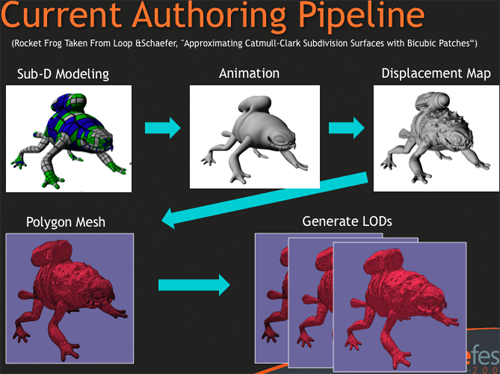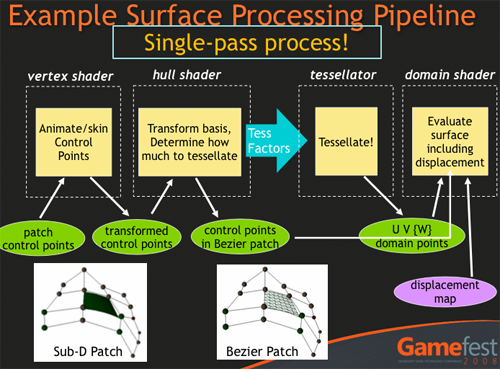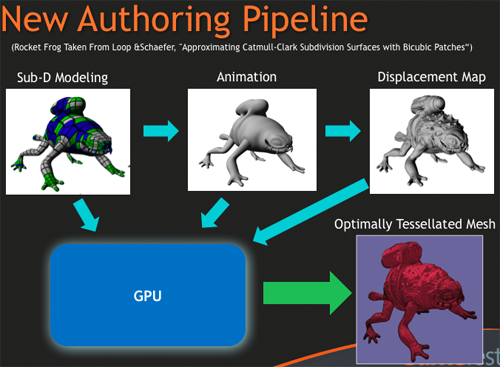Tessellation: Because The GS Isn't Fast Enough
Microsoft and AMD tend to get the most excited about tessellation whenever the topic of DX11 comes up. AMD jumped on the tessellation bandwagon long ago, and perhaps it does make sense for consoles like the XBox 360. Adding fixed function hardware to quickly and efficiently handle a task that improves memory footprint has major advantages in the living room. We still aren't sold on the need for a tessellator on the desktop, but who's to argue with progress?
Or is it really progressive? The tessellator itself is fixed function rather than programmable. Sure, the input to and output of the tessellator can be manipulated a bit through the Hull Shader and Domain Shader, but the heart of the beast is just not that flexible. The Geometry Shader is the programmable block in the pipeline that is capable of tessellation as well as much more, but it just doesn't have the power to do tessellation on any useful scale. So while most everything has been moving towards programmability in the rendering pipe, we have sort of a step backward here. But why?
The argument between fixed function and programmable hardware is always one of performance versus flexibility and usefulness. In the beginning, fixed function was necessary to get the desired performance. As time went on, it became clear that adding in more fixed function hardware to graphics chips just wasn't feasible. The transistors put into specialized hardware just go unused if developers don't program to take advantage of it. This made a shift toward architectures where expanding the pool of compute resources that could be shared and used for many different tasks became a much more attractive way to go. In the general case anyway. But that doesn't mean that fixed function hardware doesn't have it's place.
We do still have the problem that all the transistors put into the tessellator are worthless unless developers take advantage of the hardware. But the reason it makes sense is that the ROI (return on investment: what you get for what you put in) on those transistors is huge if developers do take advantage of the hardware: it's much easier to get huge tessellation performance out of a fixed function tessellator than to put the necessary resources into the Geometry Shader to allow it to be capable of the same tessellation performance programmatically. This doesn't mean we'll start to see a renaissance of fixed function blocks in our graphics hardware; just that significantly advanced features going forward may still require the sacrifice of programability in favor of early adoption of a feature. The majority of tasks will continue to be enabled in a flexible programmable way, and in the future we may see more flexibility introduced into the tessellator until it becomes fully programmable as well (or ends up just being merged into some future version of the Geometry Shader).

Now don't let this technical assessment of fixed function tessellation make you think we aren't interested in reaping the benefits of the tessellator. Currently, artists need to create different versions of their objects for different LODs (Level of Detail -- reducing or increasing complexity as the object moves further or nearer the viewer), and geometry simulation through texturing at each LOD needs to be done by pixel shaders. This requires extra work from both artists and programmers and costs a good bit in terms of performance. There are also some effects than can only be done with more geometry.

Tessellation is a great way to get that geometry in there for more detail, shadowing, and smooth edges. High geometry also allows really cool displacement mapping effects. Currently, much geometry is simulated through textures and techniques like bump mapping or parallax occlusion mapping or some other technique. Even with high geometry, we will want to have large normal maps for our lighting algorithms to use, but we won't need to do so much work to make things like cracks, bumps, ridges, and small detail geometry appear to be there when it isn't because we can just tessellate and displace in a single pass through the pipeline. This is fast, efficient, and can produce very detailed effects while freeing up pixel shader resources for other uses. With tessellation, artists can create one sub division surface that can have a dynamic LOD free of charge; a simple hull shader and a displacement map applied in the domain shader will save a lot of work, increase quality, and improve performance quite a bit.

If developers adopt tessellation, we could see cool things, and with the move to DX11 class hardware both NVIDIA and AMD will be making parts with tessellation capability. But we may not see developers just start using tessellation (or the compute shader for that matter) right away. Because DirectX 11 will run on down level hardware and at the release of DX11 we will already have a huge number cards on the market capable of running a subset of DX11 bringing with it a better, more refined, programming language in the new version of HLSL and seamless parallelization optimizations, we will very likely see the first DX11 games only implementing features that can run completely on DX10 hardware.
Of course, at that point developers can be fully confident of exploiting all the aspects of DX10 hardware, which they still aren't completely taking advantage of. Many people still want and need a DX9 path because of Vista's failure, which means DX10 code tends to be more or less an enhanced DX9 path rather than something fundamentally different. So when DirectX 11 finally debuts, we will start to see what developers could really do with DX10.
Certainly there will be developers experimenting with tessellation, but these will probably just be simple amplification to get rid of those jagged edges around curved surfaces at first. It will take time for the real advanced tessellation techniques everyone is excited about to come to fruition.










109 Comments
View All Comments
DerekWilson - Saturday, January 31, 2009 - link
These figures include "shipped" versions of Vista that people chose to downgrade to XP. It includes systems that came preinstalled, even the "vista capable" systems that people might have chosen to replace with another OS out of the box or after it didn't deliver what they expected.No Vista isn't as bad now as it was at first, but that first impression really does matter and significantly affected DirectX10 adoption, development efforts, perception, and all sorts of things that have a lasting impact on the entire industry.
Also, MS designed DX10 to be tied to the WDDM when they didn't need to in order to expose functionality for developers to use the new features of hardware. They didn't need to do this at all, and we could have had DX10 and DX11 on XP if MS hadn't wanted to push sales of Vista through needless requirements that tied future versions of DirectX to it.
michal1980 - Friday, January 30, 2009 - link
Vista bigger problem was Image. It started a bit rocky, and by the time it was 'fixed' people allready wrote it off. M$ was/is smart enough to know a damaged brand, and instead of releasing Vista Sp2, they slapped a new name on it.I do have a bit of a chip on my should about win7, from what I read, i'd love to upgrade.
But good lord, I own 2 ultimate, and 3 home preimum licenses. I hope M$ has some nice deals for vista users, because i'm going to feel a bit ripped of having an OS with a 2 year life span.
frozentundra123456 - Sunday, February 1, 2009 - link
I agree that it is a ripoff to have an OS with such a short life span. Is the "planned obsolescence" in the worst form??LeStuka - Saturday, January 31, 2009 - link
I read somewhere that Vista Ultimate owners will get a free/reduced price upgrade.. Not sure how reputable that is (my memory is a bit hazy on it) but is defiantely worth some research.marsbound2024 - Friday, January 30, 2009 - link
Let me start off by saying I was enthralled by this article. Very well detailed and well explained. There were a few occasions, however, where I wished for more explanation (or maybe my eyes skipped over an explanation you might have provided earlier in the article). I will admit, I am not as highly inclined on software as many people might be here. I am a great deal more interested in hardware usually, but when it comes to APIs such as DirectX and operating systems and their features such as Windows 7, then I am usually engrossed in those. What exactly are LODs and what is OOP constructs and what is HLSL? Now admittedly I can use Google to find all of this out, but it would be nice to have this consolidated into your article (if it was, but my eyes skimmed over that part, then I apologize; though I read your article pretty much word for word).There are a few grammatical errors such as instead of "that" you put "than" or maybe it was "then" and you said "a architectures" or something to that effect. This doesn't really matter but I thought I'd throw that out there.
I'd really like to know if the upcoming generation GPUs in June/July will make use of DirectX11? I suppose this depends on how quickly Microsoft can a good, full-featured SDK out there, perhaps. Also, albeit a bit off-topic, but any thoughts on when Windows 7 might be released to consumers? Are we still thinking later this year in time for the holiday season or the old Microsoft "by the first quarter of 2010" or whatever it was (i.e.: January possibly)?
DerekWilson - Saturday, January 31, 2009 - link
Sorry about leaving out some definitions there ... I went back and added in some explanation of what HLSL and OOP stand for and what LOD is.We suspect that the first round of hardware that comes out after Windows 7 is available will support DX11 ... We haven't had confirmation on that from either vendor yet, but that's our strong feeling at this point.
michal1980 - Friday, January 30, 2009 - link
Author just seems to have a huge chip on his shoulder.good article, that quite frankly left a bad taste in my mouth because of the unexplained, and un-needed vista bashing
tommy2q - Saturday, January 31, 2009 - link
vista 64 bit has been great for me. it's faster than xp pro on my computer and more stable.DerekWilson - Friday, January 30, 2009 - link
I don't have a problem explaining myself, I just thought it was unnecessary -- I apologize.It's not that I have a chip on my shoulder, it is simply a fact that Vista had and has problems that caused issues with the uptake of DX10. It's not a personal problem, it's just information.
First, obviously an OS upgrade was required to get DX10. People were turned off to this idea because of initial problems that were resolved after a period of time. But much damage was done.
For the first year of it's life, many drivers and applications were unstable and buggy, especially sound and graphics and especially under 64-bit Vista. MultiGPU support had its own problems, but that's a whole other barrel of monkeys. When SP1 hit most of our problems were resolved.
Performance for many tasks are decreased under Vista, though, again, much of this has been fixed. But the problem is that uptake of Vista was damaged because of this, especially among hardcore gamers and especially because there weren't any DX10 only titles or Vista only titles that were compelling (and no, Lost Planet was not compelling). Also, in cases like Crysis, DX10 incurs a huge performance hit and many gamers prefer to run DX9 anyway for the higher performance.
OS X also made huge strides and is a terrific OS. For usability, people have started to realize they had a choice in large part because Vista failed at the beginning to deliver what it promised. And choice is good.
MS recognized that they had a problem and implemented and extended again and again downgrade options to Windows XP for customers who were unsatisfied with Vista. They have significantly invested in and sped up development on Windows 7 in order to deliver an option that will regain customer interest. They've also dumped tons of money into ad campaigns like mojave and seinfeld.
Vista is not a failure in terms of total sales or market penetration as compared to other pieces of software, but it absolutely is compared to other major milestone MS OS releases. They needed to deliver a WinXP and they delivered a WinME ...
The degree to which people hung on to XP and the problems with Vista have certainly caused a delay in a full transition to DX10 programming by game developers.
Vista failed to be truly viable vehicle for pushing forward graphics technology on the whole not because it totally sucks, is lame, or any one person doesn't like it. It failed on its merits because it didn't come out of the gate as strong as it needed to be.
Certainly many developers have done some cool things with DX10. Which is great. But building a platform where people like the Beta more than their current stable OS is a good start to getting people interested in dropping Vista for Windows 7 and inspiring hold outs to finally move from Windows XP to Windows 7.
I wasn't trying to "bash" vista. I feel like I was just calling it like it is.
archer75 - Saturday, January 31, 2009 - link
All of the "problems" with Vista you mentioned actually aren't even Microsoft's or Vista's fault. Drivers are applications are the responsibilities of 3rd parties. It is they who dropped the ball. Most companies grew up with XP and that is what people learned to write drivers and apps for. With the necessary change to the driver model in Vista these people had to learn a new way of writing drivers. A necessary change but it took time.Also everything that SP1 fixed, was fixed long before SP1. All of those updates were available on the knowledge base. All SP1 did was put them in one neat little package. People like myself had those updates long before SP1.
I also run x64 and have since beta. My system has had quality drivers on day 1 and I never had any stability issues either.
Obviously an OS upgrade was required for DX10. And why wouldn't it be? Do you give away all of your new features in your old products? What company does that? You put new features in new products. Apple does this. Hell, ilife 09 is leopard only. They force you to upgrade regularly.